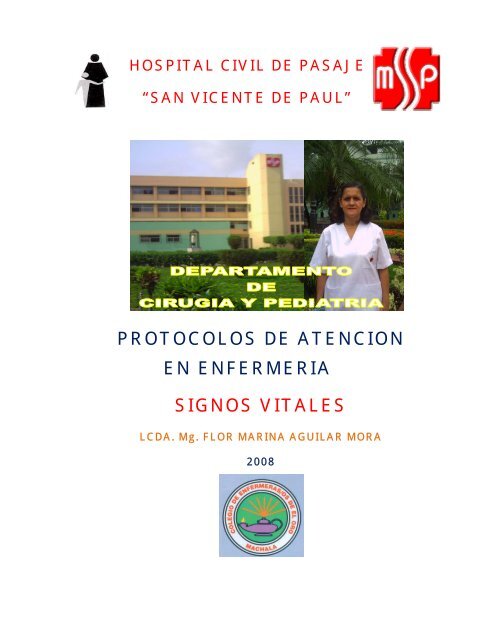PROTOCOLOS DE ATENCION EN ENFERMERIA SIGNOS VITALES
PROTOCOLOS DE ATENCION EN ENFERMERIA SIGNOS VITALES
PROTOCOLOS DE ATENCION EN ENFERMERIA SIGNOS VITALES
You also want an ePaper? Increase the reach of your titles
YUMPU automatically turns print PDFs into web optimized ePapers that Google loves.
HOSPITAL CIVIL <strong>DE</strong> PASAJE“SAN VIC<strong>EN</strong>TE <strong>DE</strong> PAUL”<strong>PROTOCOLOS</strong> <strong>DE</strong> ACTIVIDA<strong>DE</strong>S <strong>DE</strong> <strong>EN</strong>FERMERIA <strong>EN</strong> EL AREA <strong>DE</strong> CIRUGIA YPEDIATRIACONTROL <strong>DE</strong> TEMPERATURA<strong>DE</strong>FINICION: Intensidad de calor corporal medida por un termómetro.OBJETIVO: Conocer la temperatura corporal del pacienteMATERIAL Y/O EQUIPOAntisépticoBolígrafo rojoFormulario de signos vitalesTermómetro bucal y/o axilarPROCEDIMI<strong>EN</strong>TOLavado de manosPreparar material y traslado al lado delenfermoInformar al paciente el procedimiento arealizarPreservar la intimidad al pacienteBajar el mercurio del termómetro a 35ºcComprobar que la axila del paciente esteseca y libre de ropaColocar el termómetro en el centro de la axila,indicando que ponga el brazo sobre el pechoMantener el termómetro por 3 a 5 minutosRetirar y leerOBSERVACIONES:Limpieza del termómetro con agua fría y antisépticoSecarRealizar lavado de manosAnotar en el formularioEn la lectura de la temperatura axilar aumentar 0,5ºc.
HOSPITAL CIVIL <strong>DE</strong> PASAJE“SAN VIC<strong>EN</strong>TE <strong>DE</strong> PAUL”<strong>PROTOCOLOS</strong> <strong>DE</strong> ACTIVIDA<strong>DE</strong>S <strong>DE</strong> <strong>EN</strong>FERMERIA <strong>EN</strong> EL AREA <strong>DE</strong> CIRUGIA YPEDIATRIACONTROL <strong>DE</strong> FRECU<strong>EN</strong>CIA RESPIRATORIA<strong>DE</strong>FINICION: Intercambio gaseoso entre el organismo y su entorno, consta deinspiración y espiración.OBJETIVO: Cuantificar en el paciente el numero de respiraciones por minuto, asícomo las características de las mismas.MATERIAL Y/O EQUIPOFormulario de signos vitalesEstetoscopioReloj con segunderoPROCEDIMI<strong>EN</strong>TORealizar lavado de manosInformar al pacienteObservar y contar las elevaciones deltórax y/o abdomen del paciente duranteun minutoPoner la mano o estetoscopio sobre elpecho del paciente, si no se puedenobservar los movimientos torácicos paracontabilizar la frecuenciaObservar al mismo tiempo la regularidad,tipo y características de las respiracionesAnotar en los formulariosOBSERVACIONES:Al valorar la frecuencia respiratoria, comprobar si el paciente tiene hipertermiao presenta dolor.


